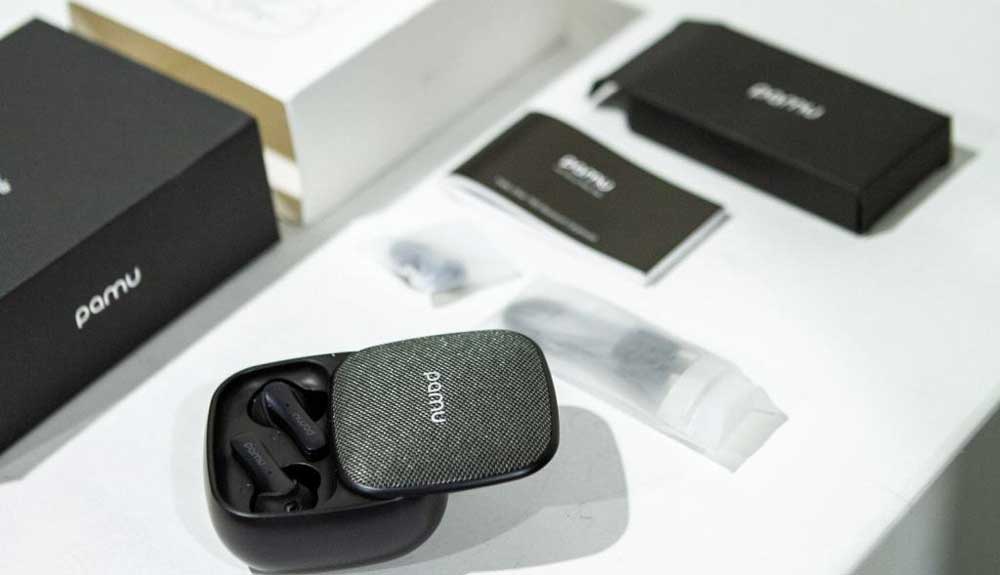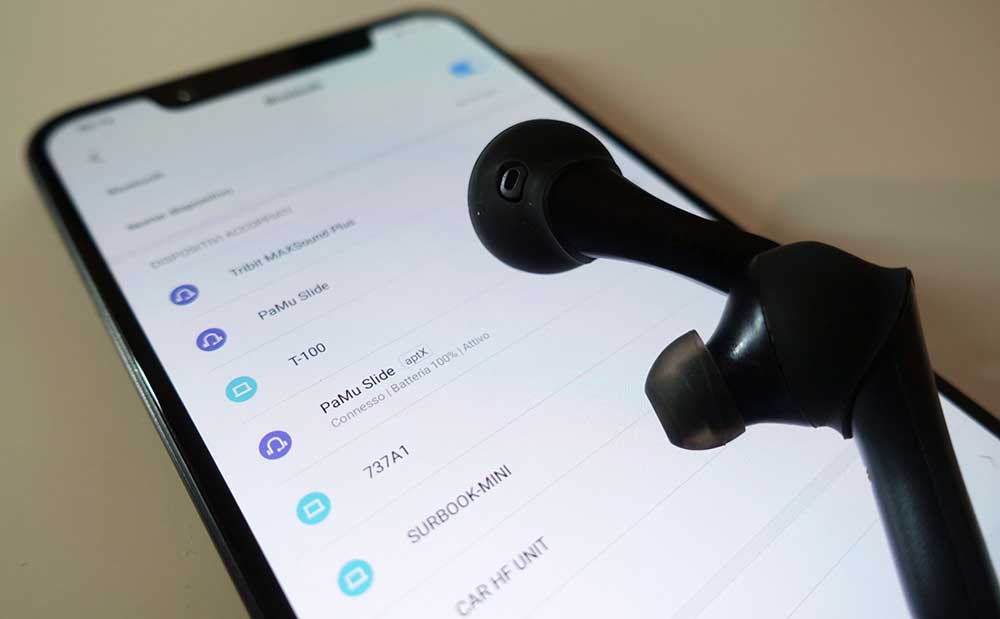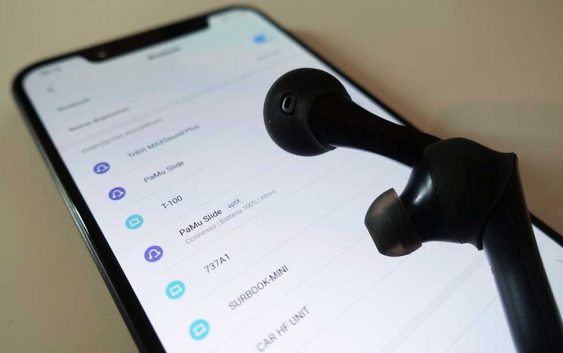PaMu has formalized the launch of the Slide, the new Bluetooth 5.0 true wireless stereo headphones from the company that go to challenge the Apple AirPods (again). PaMu is certainly not new to the world of true wireless headphones. Yes, we are talking about the same company that last year went around the web for Scrolls, the first headphones that challenged Apple’s AirPods, making this technology accessible to everyone. With the PaMu Slide the company returns to the attack of the compact wireless headset segment and this time there are all the conditions to shake the market. Find out all about the PaMu Slide in our full review!
Package unboxing
Inside the package we find:
- PaMu Slide
- Sliding houses
- 2 spare rubbers (S and L, the M are already applied on the headphones)
- USB Type-C charging cable
- Manuals, also in Italian, and warranty

Design and build quality
The PaMu Slide are small-sized wireless in ear headphones whose design is clearly inspired by that of Apple’s AirPods – an aspect that is anything but negative – but with reduced dimensions that lower the weight and reduce the discomfort that results from use extended. Each headphone measures 37.5 x 26 x 19.5 mm and weighs 7.1 grams. They are made of plastic, but covered with a silicone sheath around the area of the ear to improve stability inside the ear. The Slide headphones also enjoy IPX6 certification, meaning they can withstand rain and accidental splashes, making them perfect even for the gym.
In fact, one of the main features of these headsets is the excellent ergonomics that make them ideal for sports. We tested them for four weeks in the gym and we can confirm that they never come out of your ear, even during the race or sudden movements. The microphones on the headphones help improve the sound quality on the call thanks to a stereo noise reduction. At half height – between the pavilion and the bar – there are the entrances for the two mini-pins of the headphone charging. The LED on each earpiece turns red to indicate that charging is in progress and flashes white when connecting the slides via Bluetooth.
The charging case is – without too many words – a little too big to fit comfortably in your pocket, especially in the pockets of summer shorts. It is a case that measures 72 x 72 x 38.5 mm and weighs 135 grams, characterized by the sliding mechanism that reveals the headphones: hence the name Slide (in English scrolling). The upper part is covered in fabric, with a reticular texture that is particularly pleasant to the touch, but be careful of crumbs and dust that are easily undermined. On the back of the charging case we find a USB Type-C port, which we really appreciated since the other headphones still use a Micro-USB input. Next to the USB Type-C input there is a small button that enables wireless charging: in fact, if necessary, the case can turn into a small power-bank for charging your smartphone with Qi. A feature undoubtedly interesting and, above all, comfortable.
Functionality, gesture and connectivity
The PaMu Slide headphones are equipped with Bluetooth 5.0 connectivity, the latest standard that greatly increases the range of action – up to 4 times compared to Bluetooth 4.2, and improves packet transmission by 8 times. But the real strength of these in-ear headphones lies in the implementation of Qualcomm’s QCC3020 chipset that integrates the aptX audio codec: peculiarity of aptX is the ability to stream high quality audio without any lag. In fact, we have used the Slides with our Xiaomi Mi 8, a smartphone that correctly implements all the features of Bluetooth 5.0 (more information here) and we were pleasantly surprised by the possibility of watching movies and videos in Full HD on Netflix and YouTube without no lag between video and audio in headphones. The Qualcomm chipset also helps in pairing, which takes place within less than a second as soon as you take the headphones out of the case. A female voice announces each operation: switching on, connecting, searching for new devices and turning off the earphones.

You interact with the PaMu Slide by touches on the top of the headset, which is a touch surface. A great choice, which brings the interaction to be much more comfortable when compared to other Chinese headphones in this price range, which implement a real physical button that you have to click and that pushes the accessory inside the ear. Furthermore, since only the upper part of the headset is touched, it is possible to move and arrange the headset by taking it from the bar without interrupting the music by mistake. The Slides have an infinite number of gestures, which allow you to control everything without having to take the smartphone back into your hand – we list them all here:
- Single touch on the headphone right / left pauses or resumes playback
- Double tap on the right headphone to the next song
- Double tap on the left headset to start the voice assistant (Google Assistant, Siri or Cortana)
- When a call is received, a single touch allows you to answer while a double tap rejects it
- While on call, a single touch lets you hang up
- Holding down the right bonnet raises the volume, while on the left bonnet it lowers
We really appreciate the possibility of being able to control the volume directly from the headset, even if it is an independent volume from that of the smartphone, therefore, it will be necessary to manage two different volumes, the one set on the smartphone and that of the headphones. The touches, however, are always recognized – even with sweaty fingers – and the speed with which the instruction is passed to the smartphone is truly incredible. The practically inexistent delay helps in appreciating the experience of use even in the most urgent situations. The connection is not lost even beyond the 8/9 meters of distance between source and headphones, an excellent result.
NOTE | For the sake of completeness we have tried to connect PaMu slides to devices with Bluetooth 4.2 LE – including our Chuwi SurBook Mini and one Xiaomi Mi A1. There are no problems with music reproduction, but with the reproduction of video content at higher resolutions than HD there are micro-lag, noticeable after about a couple of minutes of playback.
Sound quality
It is useless to go around it: the most important aspect to watch out for when it comes to headphones is the quality of the audio. This means that if the quality of the sound offered is low, the entire experience of use is adversely affected and these true wireless headphones become an inconvenience rather than a convenience. Fortunately, this is not the case with the PaMu Slide, which we believe provides a very high quality level if we think of the selling price.
We have a unit with a diameter of 6 mm with a 16 Ω resistance in each earpiece, numbers that translate into high sound power. Sound power that is found particularly in the reproduction of low frequencies – always present – but which are well balanced with respect to the medium and high frequencies. The warmth of the sound coming out of the PaMu Slide is very engaging, helping to recreate a perfect stereophonic scene. In addition to the aptX format, there are also two other sound decoding formats: SBC and AAC.
When it comes to calls, on the other hand, the interlocutor’s volume is a lower thread than you’d expect, while double microphones work well in reducing background noise and isolating our voice, which, however, can be a bit muffled in some situations. In general, in environments that are not too noisy, there is no problem in using slides for calls or voice messages on WhatsApp / Telegram / Instagram.
Battery of headphones and charging case
Padmate did an excellent job of making a real U-turn with respect to the old PaMu Scrolls, with a limited autonomy and problems in battery draining when on standby. The new PaMu Slide offer a 85 mAh battery for headphones, enough to guarantee around 8 hours of continuous high quality playback, with headphone volume at maximum and smartphone volume set to 12/15. The company declares 10 hours, but in our tests we never achieved this result: it is also true that we could have lowered energy consumption by slightly lowering the volume, but our goal was to stress the earphones to the maximum. The same autonomy for calls, but we have not tested for more than a few minutes a day.
The case, on the other hand, shows the other side of the coin in this area: the questionable portability becomes a real plus when it comes to autonomy. From the moment we received the PaMu Slides at home (four weeks ago), after completely charging the houses and headphones, we used the earphones every day, between the gym, car, on foot and around. At the time of writing this review, the case still shows three LEDs lit on four, denoting a fantastic, truly enviable autonomy. In fact, inside the charging case there is a 2000 mAh battery, which however is recharged in less than 3 hours if completely discharged, thanks to the fast charging with the USB Type-C port. The headphones, on the other hand, take 90 minutes for a full charge inside the case.
Final verdict on the PaMu Slide
The PaMu Slide headphones are available for purchase on Indiegogo, where the company has started the crowdfunding campaign – at the moment with an objective reached and exceeded 8600%! At the price of $ 49, exclusive for this campaign on Indiegogo, this is definitely a best-buy product for those looking for true wireless headphones of the highest audio quality, with an infinite battery and unparalleled convenience in this price range. The growth of the company has been seen all along with respect to the previous product, which lacked some problems of youth. The PaMu Slide are without doubt the best wireless in ear headphones for the current price.
Click the link to purchase PaMu Slide on Indiegogo for just $ 49. Will you take advantage of the PaMu Slide launch price on Indiegogo to buy them? Let us know below in the comments.
Source: https://www.vogueguys.com/2019/06/pamu-slide-the-challenge-to-airpods-is-launched_post-294/
